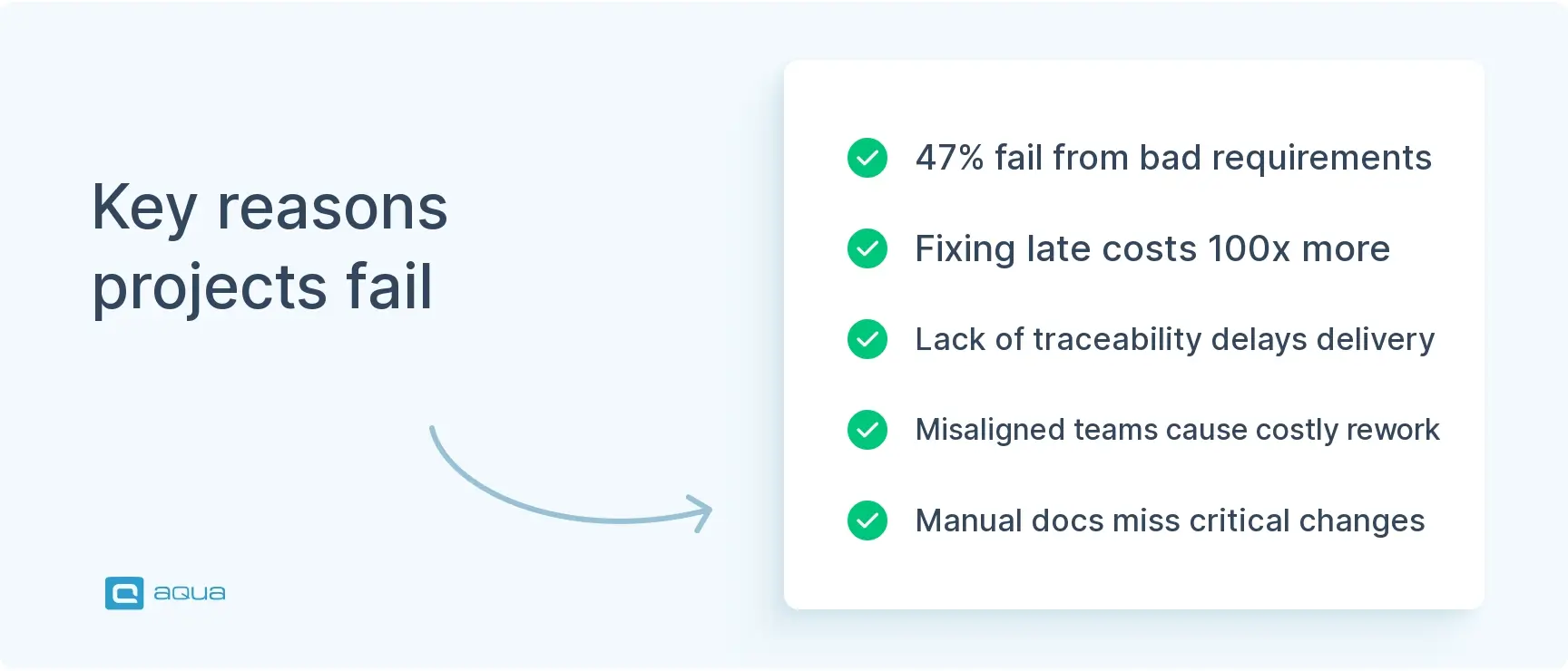Key takeaways
- Modern requirements management tools transform requirements from static documents into dynamic, traceable assets that evolve throughout the product lifecycle.
- Studies show 47% of projects fail due to requirements issues, while fixing requirements-related defects in later development stages costs up to 100 times more.
- Key features to prioritize include ease of use, collaboration capabilities, requirements traceability, and integration with existing development tools.
- Industry-specific requirements vary significantly, with medical devices needing FDA compliance features, aerospace requiring strict verification methods, and automotive demanding ASIL classification support.
- Effective requirements traceability can speed up project completion by 24% and improve accuracy by 50%, making it a critical feature in any tool.
The right requirements management tool is about finding a solution aligned with your team structure and development methodology. See how to make this strategic decision in the full article below 👇
Understanding Requirements Management Tools
Requirements management tools centralize, organize, and track project requirements throughout your entire product lifecycle. They transform requirements from static documents into dynamic assets that evolve with your product.
How requirements management evolved
Early approaches relied on Word documents and Excel spreadsheets. These worked fine for small projects, but fell apart as projects grew. Tracking changes became impossible. Keeping everyone aligned required endless email chains. Distributed teams couldn’t see what changed or why.
Modern tools fix these problems with centralized repositories where:
- Requirements stay accessible to everyone
- Changes get tracked automatically
- Relationships between requirements show clearly
- Version history preserves context
What modern tools actually do
Today’s requirements management solutions go beyond documentation. They’re collaboration hubs where stakeholders comment, review, and approve requirements in real time. They maintain complete audit trails for compliance. These tools also integrate with development and testing tools to create seamless workflows.
Requirements are living assets that guide development from start to finish. When you choose requirements management tool options, you’re picking between tools stuck in the spreadsheet era and platforms built for how teams actually work today.
Key Features to Look For
Certain features matter more than others when you’re choosing a requirements management tool. Focus on these core capabilities to narrow down options that actually meet your needs.
Ease of use comes first
The most powerful tool fails if your team finds it confusing. Look for intuitive interfaces that minimize learning curves and maximize adoption. Requirements management involves people with different technical expertise: business analysts, developers, and executives. The tool needs to work for all of them.
Good signs of usability:
- Customizable dashboards
- Logical workflows
- Clear visual cues
- Fast onboarding for new users

Collaboration features that actually help
Teams work remotely now. Strong tools offer real-time editing, commenting, and feedback mechanisms that keep everyone aligned regardless of location. Look for electronic approval workflows, notification systems that alert stakeholders to relevant changes, and the ability to assign and track review tasks. The best collaboration tools balance structured processes with flexible communication.
Requirements traceability that connects everything
Traceability establishes clear connections between requirements and related elements: customer needs, regulatory standards, design components, code, and test cases. This end to end visibility helps teams understand impact of changes, demonstrate compliance, and ensure nothing gets missed.
Integration with your existing tools
Your requirements tool needs to work within your broader development ecosystem. When you select requirements management software, look for connections to:
- Project management platforms
- Design and modeling tools
- Testing and QA systems
- Version control repositories
Strong integration means less duplicate data entry, synchronized information, and requirements flowing naturally into development activities. A good test management solution integrates well with requirements management to streamline your entire workflow. Look for tools with robust APIs that allow custom connections to your existing tech stack.
Traceability and collaboration matter across all industries when you choose a requirements management tool.
aqua cloud delivers automated end-to-end traceability that connects requirements, test cases, and defects in real time. Requirements become dynamic, traceable assets that evolve with your product instead of static documents.aqua’s domain-trained AI Copilot generates comprehensive requirements from notes, files, or images in seconds instead of hours. The AI grounds itself in your project’s actual data through RAG, ensuring outputs reflect your specific terminology and business logic. Teams using aqua save over 12 hours per week by automating previously manual tasks while improving requirements quality and coverage visibility through interactive dependency graphs and real-time dashboards. Aqua’s centralized repository combines all of your manual and automated tests in a single platform, while 100% traceability and coverage provide complete visibility into every requirement, test case, and defect across the project lifecycle.
Transform your requirements management and achieve up to 60% faster release cycles with aqua cloud
Questions to Evaluate Requirements Management Tools
The right questions help you identify tools that actually fit your needs, not just tools with impressive feature lists.
Start with your pain points
What problems are you trying to solve?
Struggling with regulatory compliance? Teams miscommunicating and causing rework? Understanding your specific pain points helps you focus on tools that address real needs instead of getting distracted by features you’ll never use.
Assess your collaboration needs
How does your team work? In office, fully remote, or hybrid? Tools for distributed teams offer more robust real-time collaboration, commenting, and notifications.
Ask vendors:
- How does your tool facilitate collaboration across locations and time zones?
- Can team members edit simultaneously?
- How do notifications work for changes to requirements someone is responsible for?
Confluence is a terrible place to store and manage requirements - particularly if your organisation doesn’t allow you to lock pages. I’ve spent the last 6 months trying to restore traceability as DAs and devs have amended signed off requirements, which has impacted releases , quality and significant additional cost (tens of thousands).
Dig into traceability capabilities
Strong tools offer bidirectional traceability. You can trace forward from requirements to implementation and tests, and backward from tests to original requirements.
Critical questions:
- Does your tool provide live traceability that updates automatically when changes occur?
- How granular is the traceability? Individual requirement level or only documents?
- How does traceability reporting work for compliance audits?
Test integration with your existing tools
List the tools your team currently uses for project management, design, development, and testing. Ask vendors specific questions about integration:
- How deep is your integration with our specific tools? Simple linking or automatic synchronization?
- Can we see a demonstration of integration with our existing systems?
Be wary of vague answers. Request concrete examples or live demonstrations.
Don’t ignore implementation and support
These factors are crucial but still get overlooked during evaluation.
Ask about:
- Typical implementation timelines
- Training resources available
- Ongoing support options
- Uptime guarantees and security measures for cloud tools
- IT resources needed for on-premises deployments
Pros and Cons of Using Requirements Management Tools
Understanding both the benefits and potential drawbacks of requirements management tools helps set realistic expectations and prepare for successful implementation.
Advantages
Improved traceability and visibility
Modern tools create clear connections between customer needs, requirements, design elements, code, and tests. Nothing falls through the cracks. Teams understand impact of changes before making them.
Enhanced collaboration
Centralized platforms enable real-time communication among distributed teams. Features like commenting, reviewing, and automated notifications keep everyone aligned regardless of location. Fewer misunderstandings. More consistent interpretation of requirements across your organization.
Reduced costs
Catching requirements defects early saves substantial money. Fixing defects caused by poor requirements costs up to 100 times more in later development stages. Requirements management tools catch ambiguities, inconsistencies, and conflicts before they become expensive problems.
Regulatory compliance support
For regulated industries, dedicated tools provide comprehensive audit trails, electronic signatures, and automated verification of requirements against standards. Organizations report up to 40% reduction in compliance-related delays.
| What Changes | Without RM Tool | With RM Tool |
|---|---|---|
| Traceability | Manual tracing through documents | Automated, real time traceability |
| Change Management | Email chains, meeting notes | Structured workflows with impact analysis |
| Collaboration | Fragmented communication | Centralized platform with real time updates |
| Compliance | Manual documentation gathering | Automated audit trails and reporting |
| Quality | Variable, depends on individuals | Consistent quality with automated checks |
Potential Drawbacks
Implementation takes effort
Adopting a new tool requires configuration, data migration, and integration with existing systems. Without proper planning, teams resist change even when current methods are inefficient.
Learning curve exists
Sophisticated tools come with steeper learning curves, potentially slowing initial adoption. Teams accustomed to documents and spreadsheets need time to adjust to structured requirements management processes.
Costs add up
Initial investment includes licenses, implementation, training, and integration. Be aware of hidden costs: add-ons, customization, training fees, and ongoing administration expenses.
Tools don’t replace processes
Teams sometimes focus on the tool rather than developing sound requirements processes. A tool supports good processes. It doesn’t create them.
The key to maximizing benefits while minimizing drawbacks: Careful selection, thoughtful implementation planning, and understanding that tools support good processes rather than substitute for them. Organizations with clear objectives and realistic expectations typically see substantial returns on investment.
Industry Specific Considerations
Medical Device Industry
Regulatory compliance dominates everything. The FDA’s 21 CFR Part 820 and ISO 13485:2016 mandate rigorous design control. The FDA’s Quality Management System Regulation Final Rule takes effect in February 2026.
Medical device developers need tools that provide:
- Complete design history files and traceability from user needs to verification
- Electronic signature capabilities for design reviews and approvals
- Risk management integration linking requirements to identified hazards
- Automated compliance reporting for regulatory submissions
- Change impact analysis with full audit trails
Companies in this space often prioritize tools with pre-configured templates specifically for medical device development. These ensure regulatory compliance while minimizing documentation burden.
Aerospace and Defense
DO-178C for software and DO-254 for hardware establish strict guidelines for airborne systems development. Requirements management tools for aerospace must support:
- Classification of requirements by Development Assurance Level
- Formal verification methods with complete coverage analysis
- Stage of Involvement review documentation
- Bidirectional traceability across the entire development V model
- Supplier management for complex supply chains
Aerospace organizations prefer tools with proven track records in their industry and certifications from relevant authorities. The cost of non-compliance can be catastrophic.
Automotive Industry
ISO 26262 functional safety standards, complex supplier networks, and increasingly software driven vehicles create specific challenges. Automotive developers need tools supporting:
- Advanced traceability across distributed development teams
- Supplier collaboration with controlled information sharing
- ASIL classification
- Support for AUTOSAR and other automotive-specific standards
- Integration with model based systems engineering tools
Financial Services
Data security, privacy regulations, and rapid market changes drive different requirements. Financial services organizations need:
- Comprehensive audit trails for SOX compliance
- Role based access controls with detailed permission settings
- Data residency controls for international operations
- Integration with IT service management platforms
- Support for agile delivery models with regulatory overlay
Look beyond generic capabilities when evaluating tools. The right tool should feel like it was designed for your industry challenges, with templates, integrations, and features that align with your regulatory environment and development methodologies.
As we’ve seen, selecting the right requirements management tool is a strategic decision that directly impacts project success rates and compliance capabilities. While many tools offer basic requirements documentation, aqua cloud delivers a complete solution that addresses the core challenges highlighted throughout this article, from traceability and collaboration to industry-specific compliance needs.
With aqua, you gain a centralized platform where requirements automatically link to test cases and defects, creating bidirectional traceability that updates in real-time. The platform’s AI Copilot, trained specifically for software testing and requirements contexts, helps teams generate high-quality requirements and test coverage in seconds rather than hours. This is beyond generic AI, since it’s grounded in your actual project data, making outputs remarkably relevant and accurate. For regulated industries like medical devices, aerospace, or financial services, aqua provides comprehensive audit trails, version histories, and custom workflows that simplify compliance. Teams using aqua report not just time savings of 12+ hours weekly, but also significantly improved quality through consistent processes and comprehensive coverage analysis.
Reduce requirements-related project failures by up to 47% with aqua's AI-powered traceability
Conclusion
Choosing the right requirements management tool directly impacts your project success, time to market, and compliance capabilities. A lot of project failures stem from requirements issues. Effective requirements management accelerates development, improves accuracy, and significantly reduces costs. Start with a clear understanding of your own needs, then systematically evaluate tools against criteria that matter most to your organization. Consider current needs and future growth, integration requirements, and total cost of ownership. AI tools for requirements are enhancing these processes by improving accuracy and offering predictive insights. The time you invest in selecting the right tool pays off throughout your entire product development lifecycle.

















